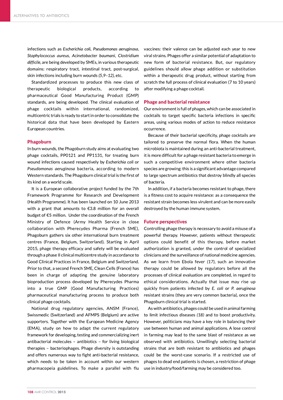
infections such as Escherichia coli, Pseudomonas aeruginosa,
Staphylococcus aureus, Acinetobacter baumani, Clostridium
difficile, are being developed by SMEs, in various therapeutic
domains: respiratory tract, intestinal tract, post-surgical,
skin infections including burn wounds (5,9-12), etc.
Standardized processes to produce this new class of
therapeutic biological products, according to
pharmaceutical Good Manufacturing Product (GMP)
standards, are being developed. The clinical evaluation of
phage cocktails within international, randomized,
multicentric trials is ready to start in order to consolidate the
historical data that have been developed by Eastern
European countries.
Phagoburn
In burn wounds, the Phagoburn study aims at evaluating two
phage cocktails, PP0121 and PP1131, for treating burn
wound infections caused respectively by Escherichia coli or
Pseudomonas aeruginosa bacteria, according to modern
Western standards. The Phagoburn clinical trial is the first of
its kind on a world scale.
It is a European collaborative project funded by the 7th
Framework Programme for Research and Development
(Health Programme). It has been launched on 10 June 2013
with a grant that amounts to €3.8 million for an overall
budget of €5 million. Under the coordination of the French
Ministry of Defence (Army Health Service in close
collaboration with Pherecydes Pharma (French SME),
Phagoburn gathers six other international burn treatment
centres (France, Belgium, Switzerland). Starting in April
2015, phage therapy efficacy and safety will be evaluated
through a phase II clinical multicentre study in accordance to
Good Clinical Practices in France, Belgium and Switzerland.
Prior to that, a second French SME, Clean Cells (France) has
been in charge of adapting the genuine laboratory
bioproduction process developed by Pherecydes Pharma
into a true GMP (Good Manufacturing Practices)
pharmaceutical manufacturing process to produce both
clinical phage cocktails.
National drug regulatory agencies, ANSM (France),
Swissmedic (Switzerland) and AFMPS (Belgium) are active
supporters. Together with the European Medicine Agency
(EMA), study on how to adapt the current regulatory
framework for developing, testing and commercializing inert
antibacterial molecules - antibiotics - for living biological
therapies - bacteriophages. Phage diversity is outstanding
and offers numerous way to fight anti-bacterial resistance,
which needs to be taken in account within our western
pharmacopeia guidelines. To make a parallel with flu
vaccines: their valence can be adjusted each year to new
viral strains. Phages offer a similar potential of adaptation to
new form of bacterial resistance. But, our regulatory
guidelines should allow phage addition or substitution
within a therapeutic drug product, without starting from
scratch the full process of clinical evaluation (7 to 10 years)
after modifying a phage cocktail.
Phage and bacterial resistance
Our environment is full of phages, which can be associated in
cocktails to target specific bacteria infections in specific
areas, using various modes of action to reduce resistance
occurrence.
Because of their bacterial specificity, phage cocktails are
tailored to preserve the normal flora. When the human
microbiota is maintained during an anti-bacterial treatment,
it is more difficult for a phage resistant bacteria to emerge in
such a competitive environment where other bacteria
species are growing: this is a significant advantage compared
to large spectrum antibiotics that destroy blindly all species
of bacteria.
In addition, if a bacteria becomes resistant to phage, there
is a fitness cost to acquire resistance: as a consequence the
resistant strain becomes less virulent and can be more easily
destroyed by the human immune system.
Future perspectives
Controlling phage therapy is necessary to avoid a misuse of a
powerful therapy. However, patients without therapeutic
options could benefit of this therapy, before market
authorization is granted, under the control of specialized
clinicians and the surveillance of national medicine agencies.
As we learn from Ebola fever (17), such an innovative
therapy could be allowed by regulators before all the
processes of clinical evaluation are completed, in regard to
ethical considerations. Actually that issue may rise up
quickly from patients infected by E. coli or P. aeruginosa
resistant strains (they are very common bacteria), once the
Phagoburn clinical trial is started.
As with antibiotics, phages could be used in animal farming
to limit infectious diseases (18) and to boost productivity.
However, politicians may have a key role in balancing their
use between human and animal applications. A lose control
in farming may lead to the same blast of resistance as we
observed with antibiotics. Unwillingly selecting bacterial
strains that are both resistant to antibiotics and phages
could be the worst-case scenario. If a restricted use of
phages to dead end patients is chosen, a restriction of phage
use in industry/food/farming may be considered too.
ALTERNATIVES TO ANTIBIOTICS
108 AMR CONTROL 2015